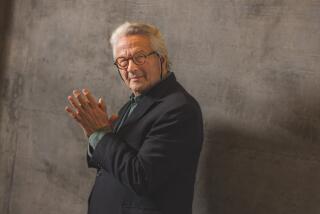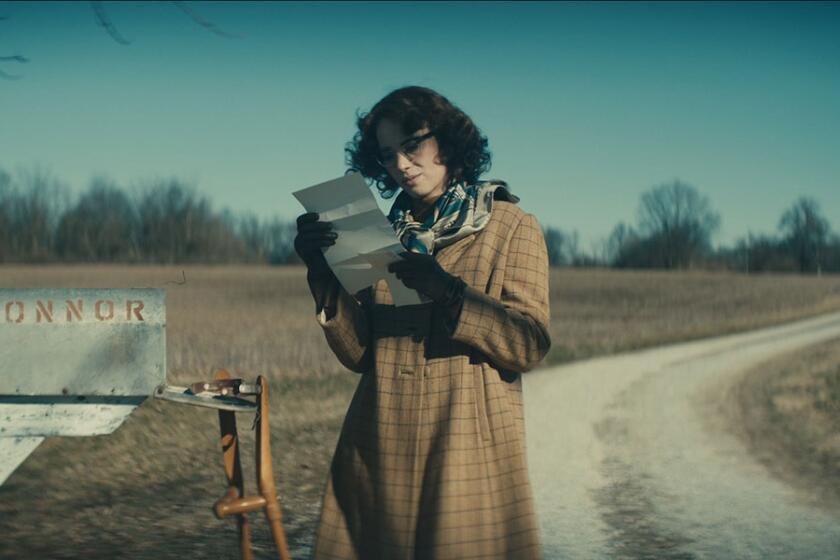The movies seldom combine real life with death penalty situations
In Michael Curtiz’s “Angels With Dirty Faces” (1938), Prohibition-era gunman Rocky Sullivan walks the last mile as unrepentant and cocky as a young James Cagney can make him. Swaggering his way into eternity, as it were. A bantam killer on his way to the block.
When he finally confronts the Chair, however, Sullivan famously goes to pieces -- begging, pleading, crying, his hands having to be pried from a radiator before the bulls can strap him in, turn on the juice and send Rocky off to meet his maker. “And he was going to spit in my eye,” a guard says, shaking his head. The priest, played by Pat O’Brien (who else?), lifts his moist eyes to heaven.
What the guard doesn’t know -- but we certainly do -- is that Father Connelly has begged Rocky to go to his death a coward. “They’ve got to despise your memory,” he says of the idol-worshiping neighborhood delinquents Sullivan has set on the road to ruin. And while the hard-as-nails Rocky dismisses Connelly’s plea at first, at the last possible moment -- in a desperate bid for his own salvation, as well as the kids’ -- he obliges his boyhood friend.
“Angels With Dirty Faces” would be a standard-issue Warner Bros. gangster flick, replete with Ann Sheridan, Humphrey Bogart and the Dead End Kids, if not for that final sequence, which makes it instead a film of operatic pathos -- and illustrious significance within the special realm of the death-penalty movie. What the aptly titled “Angels” embodies is what capital punishment usually has become on its journey to the screen: a secularized version of a passion play.
Rocky Sullivan, in other words, died for our sins.
You don’t have to flash back as far as the 1930s to see the religious handwriting on the wall (although Depression Hollywood cinema was crawling with shadow Catholicism). The final scene of “Spartacus” (1960), for instance, is one glorious state execution -- the title character and all the other rebellious slaves crucified along the Roman road in symbolic anticipation of You Know Who. The best, and best known, capital-punishment film of recent years -- Tim Robbins’ “Dead Man Walking” (1995) -- isn’t really about guilt or innocence but rather about Sister Helen Prejean (a splendid Susan Sarandon, who won an Oscar) saving the soul of the doomed Matthew Poncelet.
That Poncelet (Sean Penn) delivers his atonement speech strapped to a vertical table, his arms outstretched for his lethal injection, is not, admittedly, the most nuanced moment in the movie.
But unless it’s a comedy, Hollywood’s take on capital punishment is almost always the story of the sacrificial lamb.
Take the genre’s most recent incarnation: “The Life of David Gale,” an Alan Parker thriller, is about an anti-death-penalty activist (Kevin Spacey) who finds himself facing the big needle. Is it necessary to know anything about David Gale to know that the character will be a signifier for the messy, immoral and/or inept way American society deals with those who break its ultimate taboos? (And those taboos are not exclusive to murder: Alan Alda played rapist Caryl Chessman in 1977’s forgettable TV movie “Kill Me If You Can.” Chessman got California’s gas chamber in 1960.)
Parker, the English-born director of such America-centric movies as “Mississippi Burning” (1988), debuted his film at the recent Berlin Film Festival, where, he said, it got a “sensational reception.” This despite the current political anxieties affecting Euro-American relations and the fact that the death penalty, despite several notable examples, is almost exclusively an American topic.
“We’re very snotty about it in Europe,” Parker says during a recent visit to Manhattan. For many Europeans, the entire issue is an American one, he says, and can be boiled down to George W. Bush and the fact that as Texas governor he oversaw the most executions in the state’s history.
“But while most civilized countries have done away with” the death penalty -- a ban, Parker points out, that is a prerequisite for membership in the European Union -- “if you poll people, the number there who are for the death penalty is pretty similar to here. So we can’t be too snotty about it. You might even argue that perhaps the United States is a little more democratic because it’s fulfilling the will of the people.”
But that presumed will is hardly the thrust of “David Gale” -- or any other capital-punishment film. Movies on the subject hinge, instead, on what are seen as mechanical flaws: how a policy that’s essentially retributive, and plagued by politics, can never ensure that the innocent won’t be counted among the dead. As Kenneth Mentor, a member of New Mexico State University’s criminal justice department, points out in his paper “Death Penalty in the Movies,” a film like “The Green Mile” (1999), in which an electrocution goes horribly wrong, actually endorses capital punishment because it portrays executions as going wrong only when evil plays a hand.
Which raises one of the more curious aspects: Why is it that so few take the simple moral position that state-sponsored killing is wrong?
One that does, and one of the most devastating on the subject, is Chapter 5 of the late Polish director Krzysztof Kieslowski’s “Decalogue” (each episode of which corresponds to one of the Ten Commandments). In “Thou Shalt Not Kill,” a psychotic youth’s crime is the garroting of a cabdriver; his punishment, hanging. The way Kieslowski makes the execution as brutal as -- and similar to -- the crime itself composes as eloquent a moral statement against capital punishment as has ever been committed to film.
But in that it’s rare.
It seems clear enough that “David Gale” adopts the sacrificial-lamb motif established by so many other films, some of which are more obvious about it than others.
Death-penalty movies come in several basic flavors: those in which the accused is guilty, those in which he/she is innocent, those in which the innocent die and, most aggressively, those in which a last-minute reprieve supplies the tension and catharsis.
It’s difficult to conjure up any movie in which the ultimate penalty is meted out with any sense of justice being served. But this is largely because drama is better served by justice being denied.
One of the most celebrated -- and notorious -- capital-punishment movies is “I Want to Live!” (1958), in which Susan Hayward plays hustler, thief and part-time prostitute Barbara Graham, who was gassed in 1955. Graham’s guilt in the robbery-murder of disabled widow Mabel Monahan was never solidly proven, but neither was her innocence. For purposes of the film, however, her conviction is engineered by her co-defendants and a prosecution team driven more by bloodlust than the search for truth.
How could it be otherwise? It’s the nature of the beast. Emotional manipulation is why white women seem to occupy Hollywood’s death row far more often than anyone else. And why true evil never survives a trip to Hollywood’s death row.
Though Hayward gives a performance that was deemed Oscar-worthy then and that seems like high camp now, the one aspect of “I Want to Live!” that does remain effective is the way the process itself becomes an instrument of cruel and inhuman punishment -- Graham’s trip to the gas chamber being delayed by so many last-minute appeals that she despairs of not dying. Her Calvary becomes the cell she can’t escape, her execution a symbol of everything wrong with a society that takes an eye for an eye.
It’s good theater, so-so art and maybe even an effective lesson in mercy. But like most death-penalty movies, it doesn’t have very much to do with real life. Or, for that matter, real death.
More to Read
Only good movies
Get the Indie Focus newsletter, Mark Olsen's weekly guide to the world of cinema.
You may occasionally receive promotional content from the Los Angeles Times.






